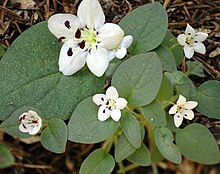
Physocarpus, commonly called ninebark, is a genus of flowering plants in the family Rosaceae, native to North America and northeastern Asia.
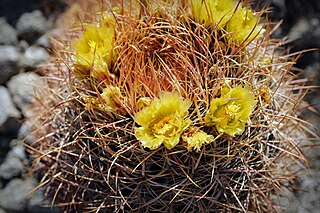
Ferocactus cylindraceus is a species of barrel cactus which is known by several common names, including California barrel cactus, Desert barrel cactus, compass barrel cactus, and miner's compass. It was first described by George Engelmann in 1853.

Systenotheca is a monotypic plant genus in the buckwheat family containing the single species Systenotheca vortriedei, which is known by the common name Vortriede's spineflower.

Triteleia crocea, with the common names yellow triteleia and yellow tripletlily, is a monocot flowering plant in the genus Triteleia.
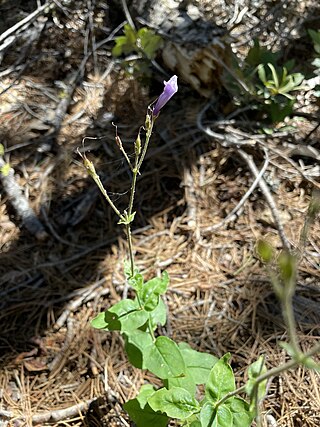
Penstemon personatus is an uncommon species of penstemon known by the common name closethroat beardtongue.
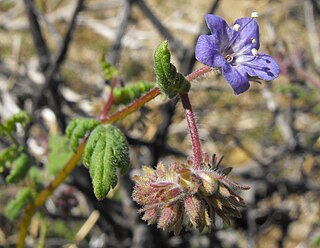
Phacelia distans is a species of flowering plant in the borage family, Boraginaceae, known by the common names distant phacelia and distant scorpionweed. It is native to the southwestern United States and northwestern Mexico, where it grows in many types of habitat, including forest, woodland, chaparral, grassland, and meadows.

Phacelia insularis, the coast phacelia is a rare species of phacelia. It is endemic to California, where it has a disjunct distribution.

Phacelia linearis, the linear-leaved phacelia or threadleaf phacelia, is a species of phacelia.

Plagiobothrys canescens is a species of flowering plant in the borage family known by the common name valley popcornflower. It is endemic to California, where it is a common wildflower in valley, foothill, desert, coastline, and canyon habitat in the central and southern regions of the state.
Ribes amarum is a species of currant known by the common name bitter gooseberry. It is endemic to California, where it is known from mountains, foothills, and canyons. Its habitat includes Chaparral.
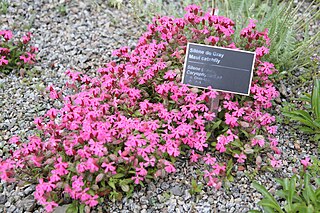
Silene grayi is a North American species of flowering plant in the family Caryophyllaceae, known by the common name Gray's catchfly.
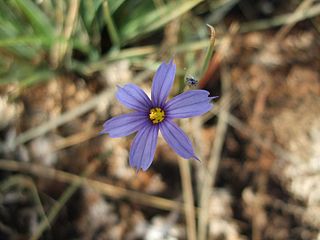
Sisyrinchium funereum is an uncommon species of flowering plant in the family Iridaceae known by the common names Funeral Mountain blue-eyed grass and Death Valley blue-eyed-grass. It is endemic to the Mojave Desert of the United States, where it is known only from the Funeral Mountains and Death Valley area in eastern California, and the Ash Meadows area just over the border in Nevada. It grows in wet, highly alkaline habitat, such as seeps and mineral springs.
Streptanthus brachiatus is a species of flowering plant in the mustard family known by the common name Socrates Mine jewelflower. It is endemic to the Inner North Coast Ranges of California north of the San Francisco Bay Area. It can be found in chaparral and woodland habitat, often on serpentine soils, in Sonoma, Lake, and Napa Counties. It is a biennial herb producing a branching stem up to about 60 centimeters in maximum height. There is a basal rosette of fleshy purple-green leaves around the base, each with a sharp-toothed, widely lance-shaped blade up to 4 centimeters long. Leaves higher on the stem vary in shape. Flowers occur at intervals along the upper stem. Each has an urn-shaped calyx of keeled yellowish or purplish sepals just under a centimeter long. White, purple, or purple-veined white petals emerge from the tip. The fruit is a thin, narrow silique which may be up to 6 centimeters in length.
Streptanthus farnsworthianus is an uncommon species of flowering plant in the mustard family known by the common name Farnsworth's jewelflower. It is endemic to California, where it is limited to the woodlands of the Sierra Nevada foothills. It is an annual herb producing a hairless, waxy, purple or purple-tinged stem up to half a meter tall or more. The ephemeral basal leaves have blades up to 15 centimeters long which are each divided into several narrow lobes or leaflets. Leaves higher on the stem have purple lance-shaped blades that generally clasp the stem at their bases. Flowers occur at intervals along the upper stem with one or two leaflike purple bracts at the base of the raceme. Each flower has an urn-shaped calyx of purple sepals up to a centimeter long. Curling purple-veined white petals emerge from the tip of the calyx. The fruit is a straight or curving silique up to 12 centimeters long.
Streptanthus howellii is an uncommon species of flowering plant in the mustard family known by the common name Howell's jewelflower. It is endemic to the Klamath Mountains of southern Oregon and northern California. It grows in mountain forests on serpentine soils. It is a perennial herb producing a hairless, often waxy-textured stem up to 70 or 80 centimeters in maximum length. It is generally unbranched. The ephemeral basal leaves have fleshy oval blades with smooth or toothed edges, borne on petioles. Leaves farther up the stem are similar but smaller and narrower, with shorter petioles or none. They do not clasp the stem. Flowers occur at intervals along the upper stem. Each has a calyx of purple sepals under a centimeter long with purple-tipped yellow petals emerging from the tip. The fruit is a thin, smooth, curved silique up to 12 centimeters long.

Tricardia is a monotypic genus of flowering plants in the borage family containing the single species Tricardia watsonii, which is known by the common name threehearts. It is native to the southwestern United States, where it grows in deserts and mountains in sandy open habitat, often beneath shrubs. It is a perennial herb growing from a taproot and a woody caudex covered with the shreddy remains of previous seasons' herbage. It produces several erect stems up to about 40 centimeters tall. Most of the leaves are located in a basal rosette about the caudex. They are lance-shaped and coated thinly in woolly hairs. They are up to 9 centimeters long and are borne on petioles. A few smaller leaves occur higher on the stem. Flowers occur in a loose cyme at the top of the stem. Each has a calyx of five sepals. The outer three are heart-shaped and green to pink or purple in color, and the inner two are much smaller and narrower. The flower within is bell-shaped, white with central purple markings, and roughly half a centimeter wide. The fruit is a capsule just under a centimeter long which contains 4 to 8 seeds.
Trifolium bolanderi is a species of clover known by the common names Bolander's clover and parasol clover.
Tripterocalyx crux-maltae is a species of flowering plant in the four o'clock family known by the common names Lassen sandverbena and Kellogg's sand-verbena.

Triteleia dudleyi is a species of flowering plant known by the common name Dudley's triteleia. It is endemic to California, where it is known from sections of the High Sierra Nevada and the Transverse Ranges. It is a plant of subalpine climates, growing in mountain forests. It is a perennial herb growing from a corm. It produces two or three basal leaves up to 30 centimeters long by one wide. The inflorescence arises on an erect stem up to 30 or 35 centimeters tall and bears an umbel-like cluster of many flowers. Each flower is a funnel-shaped yellow bloom that dries purple. The flower has six lobes measuring up to 1.2 centimeters long. There are six stamens with lavender anthers.
Senecio ertterae is a species of flowering plant in the aster family known by the common name Ertter's ragwort. It is endemic to Oregon, United States.
